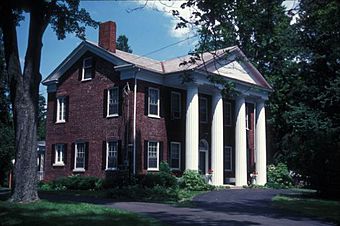Hunt House (Waterloo, New York) facts for kids
Quick facts for kids |
|
|
Hunt House
|
|
 |
|
| Location | 401 E. Main St., Waterloo, New York |
|---|---|
| Area | 1.9 acres (0.77 ha) |
| Built | 1848 |
| MPS | Women's Rights Historic Sites TR |
| NRHP reference No. | 80000358 |
| Added to NRHP | August 29, 1980 |
The Hunt House is a very important historic home located in Waterloo, Seneca County, New York. It was built around 1830. This two-story brick house has a special front porch called a portico. This porch is supported by four strong Doric order columns. The house was updated to look as it does today in the 1920s.
The Hunt House is famous because of a secret meeting that happened there. On July 13, 1848, Mrs. Jane C. Hunt invited several important women to her home. These women were Lucretia Mott, Elizabeth Cady Stanton, Martha Coffin Wright, and Mary Ann M'Clintock. They met to plan the First Women's Rights Convention in the United States. This convention was a huge step for women's equality.
Contents
A Meeting That Changed History
The meeting at the Hunt House was a key moment for women's rights. These five women gathered to discuss how to improve women's lives. At that time, women had very few rights. They couldn't vote, own property easily, or get the same education as men.
Planning the Seneca Falls Convention
During their meeting, the women decided to organize a larger gathering. This gathering would be called the Seneca Falls Convention. It would be the first convention in the United States focused on women's rights. They wanted to discuss the social, civil, and religious rights of women.
The Declaration of Sentiments
At the Hunt House, the women also started writing a very important document. It was called the "Declaration of Sentiments." This document was modeled after the Declaration of Independence. It listed the ways women were treated unfairly. It also called for equal rights for women, including the right to vote.
Key Figures in the Women's Rights Movement
The women who met at the Hunt House were leaders in the early women's rights movement.
Jane Hunt: The Hostess
Jane Hunt was a Quaker and an activist. She believed strongly in equal rights for all people. Her home provided a safe and private place for this important meeting. Without her hospitality, the planning might not have happened so easily.
Elizabeth Cady Stanton: A Powerful Voice
Elizabeth Cady Stanton was a writer and speaker. She was one of the main organizers of the Seneca Falls Convention. She helped write the Declaration of Sentiments. She spent her life fighting for women's suffrage (the right to vote).
Lucretia Mott: An Experienced Activist
Lucretia Mott was also a Quaker minister and an abolitionist. She had been fighting for social justice for many years. Her experience and wisdom were very valuable to the group. She helped guide the discussions at the Hunt House.
Martha Coffin Wright and Mary Ann M'Clintock
Martha Coffin Wright was Lucretia Mott's sister. She was also a strong supporter of women's rights and abolition. Mary Ann M'Clintock was another Quaker activist. Both women played important roles in planning the convention and supporting the cause.
The Seneca Falls Convention's Impact
The Seneca Falls Convention took place just a few days after the meeting at the Hunt House. It was held on July 19 and 20, 1848, in Seneca Falls, New York. Around 300 people attended, including men and women.
Demanding Equal Rights
At the convention, the Declaration of Sentiments was formally presented. It was a bold statement for its time. It demanded that women be treated as equal citizens. This event marked the beginning of the organized women's rights movement in the United States.
A Legacy of Change
The ideas discussed at the Hunt House and the Seneca Falls Convention led to many changes. Over the next decades, women fought for and slowly gained more rights. This included the right to own property, access to education, and eventually, the right to vote in 1920.
National Recognition
The Hunt House is recognized for its historical importance. It was listed on the National Register of Historic Places in 1980. This means it is a special place that is protected because of its role in American history. It is a reminder of the brave women who started the fight for equality.



